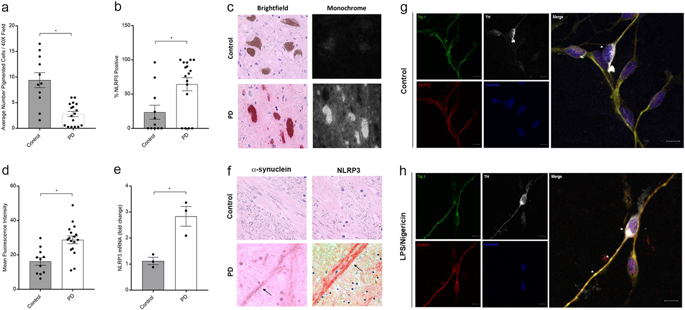npj Parkinson's Disease ( IF 6.7 ) Pub Date : 2018-08-15 , DOI: 10.1038/s41531-018-0061-5 Katharine M. von Herrmann , Lucas A. Salas , Eileen M. Martinez , Alison L. Young , Joseph M. Howard , Mary S. Feldman , Brock C. Christensen , Owen M. Wilkins , Stephen L. Lee , William F. Hickey , Matthew C. Havrda

|
Neuroinflammation is a well-characterized pathophysiology occurring in association with the progression of Parkinson’s disease. Characterizing the cellular and molecular basis of neuroinflammation is critical to understanding its impact on the incidence and progression of PD and other neurologic disorders. Inflammasomes are intracellular pro-inflammatory pattern-recognition receptors capable of initiating and propagating inflammation. These cellular complexes are well characterized in the innate immune system and activity of the NLRP3 inflammasome has been reported in microglia. NLRP3 inflammasome activity has been associated with Alzheimer’s disease, and recent reports, from our laboratory and others, indicate that Nlrp3 is required for neuroinflammation and nigral cell loss in animal models of PD. NLRP3 has not yet been characterized in PD patients. Here we characterize NLRP3 in PD using immunohistologic and genetic approaches. Histologic studies revealed elevated NLRP3 expression in mesencephalic neurons of PD patients. Analysis of exome sequencing data for genetic variation of NLRP3 identified multiple single-nucleotide polymorphisms (SNPs) including rs7525979 that was associated with a significantly reduced risk of developing PD. Mechanistic studies conducted in HEK293 cells indicated that the synonymous SNP, NLRP3 rs7525979, alters the efficiency of NLRP3 translation impacting NLRP3 protein stability, ubiquitination state, and solubility. These data provide evidence that dopaminergic neurons are a cell-of-origin for inflammasome activity in PD and are consistent with recent animal studies, suggesting that inflammasome activity may impact the progression of PD.
中文翻译:

中脑神经元中的NLRP3表达和罕见的NLRP3多态性与帕金森氏病风险降低相关的特征
神经炎症是与帕金森氏病进展相关的充分表征的病理生理学。表征神经炎症的细胞和分子基础对于了解其对PD和其他神经系统疾病的发生和发展的影响至关重要。炎症小体是能够引发和传播炎症的细胞内促炎模式识别受体。这些细胞复合物在先天免疫系统中得到充分表征,NLRP3炎性小体的活性已在小胶质细胞中报道。NLRP3炎症小体活性与阿尔茨海默氏病有关,最近来自我们实验室和其他机构的报告表明,Nlrp3是PD动物模型中神经炎症和黑质细胞丢失所必需的。尚未在PD患者中鉴定NLRP3。在这里,我们使用免疫组织学和遗传学方法表征PD中的NLRP3。组织学研究显示PD患者中脑神经元中NLRP3表达升高。对NLRP3遗传变异的外显子组测序数据进行分析,确定了包括rs7525979在内的多个单核苷酸多态性(SNP),与显着降低PD发生风险相关。在HEK293细胞中进行的机理研究表明,同义SNP NLRP3 rs7525979改变了NLRP3的效率翻译会影响NLRP3蛋白质的稳定性,泛素化状态和溶解度。这些数据提供了证据,表明多巴胺能神经元是PD中炎症小体活性的起源细胞,并且与最近的动物研究一致,表明炎症小体活性可能会影响PD的进程。











































 京公网安备 11010802027423号
京公网安备 11010802027423号